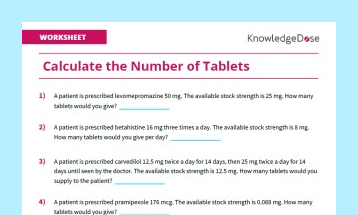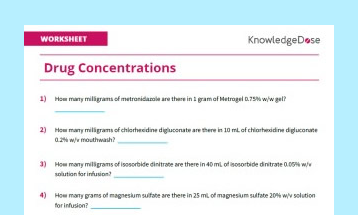Search the medical calculators section for links to medical, clinical and dosage calculators such as HbA1c, cardiovascular risk, stroke risk, BSA (body surface area), warfarin and corticosteroids. These links are aimed at physicians and pharmacists.
- Source: globalrph.com
- Clinical Resource: Calculators
- Register to Access Content: No
This is a site for medical professionals to help us do calculations and process algorithms and scores. To make patients better. Faster. You can access the full list through the navigation bars, or, preferably, through the search menu.
- Source: mdcalc.com
- Clinical Resource: Calculators
- Register to Access Content: No
Find below a chemical conversion table containing chemical compounds with factors for conversion from conventional to SI units as well as a calculator for conversions of all listed chemicals and substances.
- Source: soc-bdr.org
- Clinical Resource: Calculator
- Register to Access Content: No
Body Surface Area Calculator
DuBois / DuBois Formula
- Source: crab.org
- Clinical Resource: Calculator
- Register to Access Content: No
Body Surface Area Calculator for medication doses
Calculates Body Surface Area for medication doses and includes descriptive statistics
- Source: halls.md
- Clinical Resource: Calculator
- Register to Access Content: No
Body Surface Area Calculator (Mosteller)
- Source: patient.info
- Clinical Resource: Calculator
- Register to Access Content: No
Framingham Heart Study
Risk Functions
Risk prediction estimates for the risk of various cardiovascular disease outcomes in different time horizons are available as score sheets and direct risk functions. The choice of the appropriate risk prediction algorithm should take into account the following components: cardiovascular outcome, population of interest, time horizon, and risk factors. Outcome specific algorithms preceded by the descriptions of the above four components are available for the following:
- Atrial Fibrillation (10-year risk) and Calculator
- Cardiovascular Disease (10-year risk) and Calculator
- Cardiovascular Disease (30-year risk) and Calculator – HCVD
- Congestive Heart Failure
- Hard Coronary Heart Disease (10-year risk) and Calculator
- Coronary Heart Disease (10-year risk)
- Recurrent Coronary Heart Disease
- Coronary Heart Disease (2-year risk) – First Event
- Diabetes
- Hypertension and Calculator
- Intermittent Claudication
- Stroke
- Stroke after Atrial Fibrillation and Calculator
- Stroke or Death after Atrial Fibrillation and Calculator
- Source: framinghamheartstudy.org
- Clinical Resource: Calculator
- Register to Access Content: No
UK Prospective Diabetes Study Risk Engine
Risk calculators based on equations from the Framingham Heart Study tend to underestimate risks for people with diabetes as this study included relatively few diabetic subjects. The UKPDS Risk Engine is a type 2 diabetes specific risk calculator based on 53,000 patients years of data from the UK Prospective Diabetes Study, which also provides an approximate ‘margin of error’ for each estimate.
- Source: dtu.ox.ac.uk
- Clinical Resource: Calculator
- Register to Access Content: No
QRISK®3
Welcome to the QRISK®3-2018 Web Calculator. The QRISK®3 algorithm calculates a person’s risk of developing a heart attack or stroke over the next 10 years. It presents the average risk of people with the same risk factors as those entered for that person.
- Source: qrisk.org
- Clinical Resource: Calculator
- Register to Access Content: No
HeartScore: The interactive tool for predicting and managing the risk of heart attack and stroke in Europe
HeartScore® is a risk prediction and management web-based program aimed at supporting clinicians in optimising individual cardiovascular risk reduction. The HeartScore® web-based program is based on the internet technology and uses the risk function and data from the SCORE (Systematic Coronary Risk Evaluation) project.
The HeartScore® web-based program has been scientifically developed by the European Society of Cardiology
- Source: heartscore.org
- Clinical Resource: Tool
- Register to Access Content: Yes – registration is FREE
JBS3 Risk Calculator
Joint British Societies for Prevention of Cardiovascular Disease
The JBS3 risk calculator is a tool to help communicate the risk of CVD and the benefits of interventions, whether they are lifestyle or pharmacological.
The JBS3 Risk Calculator with its new measures and communication tools aims to empower patients to make appropriate decisions about their lifestyle and drug treatments based on a better understanding of their personal cardiovascular disease (CVD) risks. It helps GPs and Clinicians to address three key questions for their patients:
- Why should I start CVD risk reduction?
- When should I start?
- What should I do?
- Source: jbs3risk.com
- Clinical Resource: Calculator
- Register to Access Content: No
The ASSIGN Score
ASSIGN is a cardiovascular risk score developed in Dundee University, Scotland in 2006.
ASSIGN includes social deprivation for the first time, and family history of cardiovascular disease with the classic risk factors.
It identifies people free of cardiovascular disease most likely to develop it over ten years. ‘High risk’ (score 20 or more) implies risk-lowering medication and/or other medical help.
ASSIGN is the cardiovascular risk score chosen for use by SIGN (Scottish Intercollegiate Guidelines Network) and Scottish Government Health Directorates.
- Source: assign-score.com
- Clinical Resource: Calculator
- Register to Access Content: No
The Seattle Heart Failure Model (SHFM) is a calculator of projected survival at baseline and after interventions for patients with heart failure.
- Source: washington.edu
- Clinical Resource: Calculator
- Register to Access Content: No
SPARC – Stroke Prevention in Atrial Fibrillation Risk Tool
for estimating risk of stroke and benefits & risks of antithrombotic therapy in patients with chronic atrial fibrillation
- Source: sparctool.com
- Clinical Resource: Tool
- Register to Access Content: No
Predicting risk with oral anticoagulants
The CHA2DS2-VASc and HAS-BLED scores are well established for evaluating stroke risk for patients with atrial fibrillation (AF) and bleeding risk, respectively.
- Source: nps.org.au
- Clinical Resource: Article
- Register to Access Content: No
FRAX®
WHO Fracture Risk Assessment Tool
The FRAX® tool has been developed by WHO to evaluate fracture risk of patients. It is based on individual patient models that integrate the risks associated with clinical risk factors as well as bone mineral density (BMD) at the femoral neck.
The FRAX® models have been developed from studying population-based cohorts from Europe, North America, Asia and Australia. In their most sophisticated form, the FRAX® tool is computer-driven and is available on this site. Several simplified paper versions, based on the number of risk factors are also available, and can be downloaded for office use.
The FRAX® algorithms give the 10-year probability of fracture. The output is a 10-year probability of hip fracture and the 10-year probability of a major osteoporotic fracture (clinical spine, forearm, hip or shoulder fracture).
- Source: shef.ac.uk
- Clinical Resource: Various
- Register to Access Content: No
QFracture
QFracture is used to estimate an individual’s risk of developing
- hip fracture or
- osteoporotic fracture (hip, spine, wrist or shoulder)
over the next 10 years.
The algorithms can be used to identify people at high risk of these fractures so they can be assessed in more detail to reduce their risk.
- Source: qfracture.org
- Clinical Resource: Various
- Register to Access Content: No
10-Year Fracture Risk Calculator
The FORE 10-Year Fracture Risk Calculator™ (FORE FRC) Version 2.0 published 12/4/2012 estimates 10-year fracture risk for postmenopausal women and men age 45 and older who are not receiving treatment for osteoporosis.
- Source: riskcalculator.fore.org
- Clinical Resource: Calculator
- Register to Access Content: No
SpirXpert
The SpirXpert website aims at promoting understanding respiratory physiology and pathophysiology. The emphasis is on the measurement and interpretation of spirometric test results.
- Source: spirxpert.com
- Clinical Resource: Various
- Register to Access Content: No
Spirometry Reference Value Calculator
Enter Age, Height, Gender and Race. To see Percent Prediced, you must enter observed FVC, FEV1, and FEF25-75% values in the appropriate boxes.
- Source: cdc.gov
- Clinical Resource: Calculator
- Register to Access Content: No
Calculators | American Thyroid Association
Calculators
Calcitonin and Carcinoembryonic Antigen (CEA) Doubling Time Calculator
Change in Thyroid Nodule Volume Calculator
Thyroid Cancer Staging Calculator
- Source: thyroid.org
- Clinical Resource: Calculators
- Register to Access Content: No
HOMA Calculator
The HOMA Calculator uses the HOMA2 model to estimate beta cell function (%B) and insulin sensitivity (%S) for an individual from simultaneously measured fasting plasma glucose and fasting plasma RIA insulin values. Fasting specific insulin or C-peptide values can be used instead of RIA insulin. The HOMA2 model is calibrated to give %B and %S values of 100% in normal young subjects when using a suitable insulin assay.
- Source: dtu.ox.ac.uk
- Clinical Resource: Calculator
- Register to Access Content: No
Conversion of Glucose Values from mg/dl to mmol/l
- Source: soc-bdr.org
- Clinical Resource: Calculator
- Register to Access Content: No
Sodium Correction for Glucose Medical Calculator
- Source: ebmconsult.com
- Clinical Resource: Calculator
- Register to Access Content: No
Osmolality Gap Calculator
The osmolality gap (OG) is an indication of unmeasured solute in the blood. It is determined by the measured osmolality (MO) minus the calculated osmolality (CO).
- Source: healthcare.uiowa.edu
- Clinical Resource: Calculator
- Register to Access Content: No
Anion Gap Calculator
- Source: oncologynurseadvisor.com
- Clinical Resource: Calculator
- Register to Access Content: No
ABG interpreter. Automatic ABG interpretation.
- Source: prognosis.org
- Clinical Resource: Calculator
- Register to Access Content: No
- Source: ebmconsult.com
- Clinical Resource: Calculator
- Register to Access Content: No
Ideal Body Weight Calculator with IVIg Dosing
The Dose Calculator is intended to be used when determining the dose of IVIG for clinically obese patients; it is not recommended for paediatric patients nor any patients (incl. adults) under 5ft in height.
- Source: transfusionontario.org
- Clinical Resource: Calculator
- Register to Access Content: No
WarfarinDosing.org
Welcome to WarfarinDosing.org, a free Web site to help doctors and other clinicians begin warfarin therapy by estimating the therapeutic dose in patients new to warfarin. This site is supported by the Barnes-Jewish Hospital at Washington University Medical Center, the NIH, and donations. Estimates are based on clinical factors and (when available) genotypes of two genes: cytochrome P450 2C9 (CYP2C9) and vitamin K epoxide reductase (VKORC1).
Recommendations on this Web site are based on data from over 1000 patients.Once information is entered onto the next page, the initial estimate of therapeutic dose explains 53% of the variability in a warfarin dose. If you return to the Web site and enter an INR value after 3 and/or 4 warfarin doses, the dose refinement is even more accurate.
- Source: warfarindosing.org
- Clinical Resource: Calculator
- Register to Access Content: No
Corticosteroid Equivalent Dose Calculator
sterconv.html is a Javascript application which converts milligrams of various corticosteroids to the equivalent dose of Methylprednisolone. The conversion data is adapted from Goodman and Gilman’s The Pharmacological Basis of Therapeutics, 9th ed.
- Source: hedwig.mgh.harvard.edu
- Clinical Resource: Calculator
- Register to Access Content: No
Resources last checked: 11/08/2021



